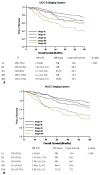Application of the revised lung cancer staging system (IASLC Staging Project) to a cancer center population
- PMID: 19619787
- PMCID: PMC2731793
- DOI: 10.1016/j.jtcvs.2009.01.033
Application of the revised lung cancer staging system (IASLC Staging Project) to a cancer center population
Abstract
Objective: The International Association for the Study of Lung Cancer (IASLC) proposed a revision to the Union Internationale Contre le Cancer (UICC-6) staging system for non-small cell lung cancer. The goal of our study was to compare these systems in patients undergoing surgery for non-small cell lung cancer to determine whether one system is superior in staging operable disease.
Methods: Pathologic stages in 1154 patients undergoing complete resection over a 9-year period were analyzed. Patients were assigned a stage based on both IASLC and UICC-6 systems. We tested for statistically meaningful differences between the two staging systems using the Wilcoxon signed rank test and the permutation test.
Results: The IASLC system is more effective than the UICC-6 system at ordering and differentiating patients (P = .009). Application of the IASLC system resulted in 202 (17.5%) patients being reassigned to a different stage (P = .012), with the most common shifts occurring from IB to IIA and IIIB to IIIA. The 5-year and median survivals of the IASLC IIIA patients including those shifted from the UICC-6 IIIB were 37% and 35 months, respectively. Reclassifying UICC-6 IIIB to IASLC IIIA did not reduce survival for the newly characterized IIIA cohort.
Conclusion: Our data confirm that the proposed IASLC staging system is more effective at differentiating stage than the UICC-6 system. Reclassifying patients from UICC-6 IIIB to IASLC IIIA will shift some patients from a stage previously considered unresectable to a stage frequently offered surgical resection. Further study and validation of the IASLC system are warranted.
Figures



Similar articles
-
Use of the proposals of the international association for the study of lung cancer in the forthcoming edition of lung cancer staging system to predict long-term prognosis of operated patients.Cancer J. 2010 Mar-Apr;16(2):176-81. doi: 10.1097/PPO.0b013e3181ce474e. Cancer J. 2010. PMID: 20404615
-
Validation of the lung cancer staging system revisions using a large prospective clinical trial database (ACOSOG Z0030).Eur J Cardiothorac Surg. 2013 May;43(5):911-4. doi: 10.1093/ejcts/ezs520. Epub 2012 Sep 26. Eur J Cardiothorac Surg. 2013. PMID: 23014970 Free PMC article.
-
Evaluation of the new TNM staging system proposed by the International Association for the Study of Lung Cancer at a single institution.J Thorac Cardiovasc Surg. 2009 May;137(5):1180-4. doi: 10.1016/j.jtcvs.2008.09.030. Epub 2009 Mar 9. J Thorac Cardiovasc Surg. 2009. PMID: 19379988
-
Non-small cell lung cancer staging: proposed revisions to the TNM system.Cancer Imaging. 2008 Sep 30;8(1):181-5. doi: 10.1102/1470-7330.2008.0029. Cancer Imaging. 2008. PMID: 18824424 Free PMC article. Review.
-
The revised TNM staging system for lung cancer.Ann Thorac Cardiovasc Surg. 2009 Feb;15(1):4-9. Ann Thorac Cardiovasc Surg. 2009. PMID: 19262443 Review.
Cited by
-
Integrative proteomics and tissue microarray profiling indicate the association between overexpressed serum proteins and non-small cell lung cancer.PLoS One. 2012;7(12):e51748. doi: 10.1371/journal.pone.0051748. Epub 2012 Dec 19. PLoS One. 2012. PMID: 23284758 Free PMC article.
-
Association between epidermal growth factor receptor gene copy number and ERCC1, BRCA1 protein expression in Chinese patients with non-small cell lung cancer.Med Oncol. 2014 Mar;31(3):803. doi: 10.1007/s12032-013-0803-5. Epub 2014 Jan 23. Med Oncol. 2014. PMID: 24452282
-
Protein signature of lung cancer tissues.PLoS One. 2012;7(4):e35157. doi: 10.1371/journal.pone.0035157. Epub 2012 Apr 11. PLoS One. 2012. PMID: 22509397 Free PMC article.
-
Unlocking biomarker discovery: large scale application of aptamer proteomic technology for early detection of lung cancer.PLoS One. 2010 Dec 7;5(12):e15003. doi: 10.1371/journal.pone.0015003. PLoS One. 2010. PMID: 21170350 Free PMC article.
-
Extended resections of non-small cell lung cancers invading the aorta, pulmonary artery, left atrium, or esophagus: can they be justified?Thorac Surg Clin. 2014 Nov;24(4):457-64. doi: 10.1016/j.thorsurg.2014.07.012. Epub 2014 Sep 11. Thorac Surg Clin. 2014. PMID: 25441139 Free PMC article. Review.
References
-
- Naruke T, Goya T, Tsuchiya R, Suemasu K. Prognosis and survival in resected lung carcinoma based on the new international staging system. J Thorac Cardiovasc Surg. 1988;96:440–7. - PubMed
-
- Thomas PA, Piantadose S Lung Cancer Study Group. Postoperative T1 N0 non–small cell lung cancer. J Thorac Cardiovasc Surg. 1978;94:349–54. - PubMed
-
- Martini N, Burt ME, Bains MS, McCormack PM, Rusch VW, Ginsberg RJ. Survival after resection of stage II non–small cell lung cancer. Ann Thorac Surg. 1992;54:460–6. - PubMed
-
- Burt ME, Pomerantz AH, Bains MS, McCormack PM, Kaiser LR, Hilaris BS, et al. Results of surgical treatment of stage III lung cancer invading the mediastinum. Surg Clin North Am. 1987;67:987–1000. - PubMed
-
- AJCC cancer staging handbook/American Joint Committee on Cancer. 6. Philadelphia: Lippincott-Raven; 2002.
Appendix References
-
- Klein JP, Moeschberger ML. Survival analysis: techniques for censored and truncated data. Berlin, New York: Springer-Verlag; 1997.
-
- Cantor A. Extending SAS survival analysis techniques for medical research. Cary (NC): SAS Institute; 1997.
-
- Efron B, Tibshirani R. An introduction to the bootstrap. London, New York: Chapman & Hall Ltd; 1993.
Publication types
MeSH terms
Grants and funding
LinkOut - more resources
Full Text Sources

